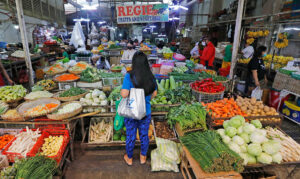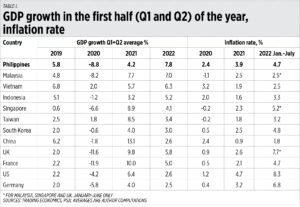Inflation may cut 2023 growth — NEDA

A SUSTAINED “inflation shock” could cut the Philippines’ gross domestic product (GDP) by 0.6% in 2023, National Economic and Development Authority (NEDA) and Socioeconomic Planning Secretary Arsenio M. Balisacan said on Tuesday.
“We are particularly concerned about higher inflation. Our analysis shows that sustained increases in inflation in 2022 and 2023 will cause a slowdown in our economic growth, translating into a GDP level lower by 0.6% in 2023 than its expected level had there been no sustained inflation shock,” he told a televised press briefing in Malacañang.
The government is targeting 6.5-7.5% GDP growth this year, and 6.5-8% expansion next year until 2028.
Inflation quickened to 6.9% in September, the sixth straight month that inflation breached the Bangko Sentral ng Pilipinas’ (BSP) 2-4% target this year.
Mr. Balisacan and the rest of the economic team on Tuesday met with President Ferdinand R. Marcos, Jr., who said on Twitter the fight against inflation was a top priority.
“While we expect our poverty situation to improve as we continue our recovery, inflation and rising interest rates will mute this improvement,” Mr. Balisacan said.
The rise in inflation is only “temporary,” he said, despite the continued increase in prices of food, oil and utilities.
“It is expected to slow down and return to the medium-term target of 2-4%. We maintain that the country’s economic prospects remain bright as we get our priorities straight and our acts right,” Mr. Balisacan said.
The BSP expects inflation to average 5.6% this year, before easing to 4.1% in 2023 and 3% in 2024.
Mr. Balisacan said one short-term solution to inflation is providing financial assistance to the most affected sectors.
“Part (of our solutions) is providing assistance to most vulnerable groups by continuing the subsidy programs for example that are currently extended by the Department of Social Welfare and Development, assistance to farmers and fisherfolk, to drivers and so on and so forth,” he said.
“We seek solutions for short term challenges, we are very careful that we do not compromise our medium-term goals which is to put the economy to a higher growth trajectory to achieve more jobs and reduce poverty — that’s the overall architecture of the plan,” he added.
Inflation in the Philippines and other Asian economies have accelerated in the past year due to the Russia-Ukraine war, supply constraints and lower agricultural production due to natural calamities, Mr. Balisacan said.
“As a result, inflation has remained persistently high globally, driven by rapid price increases in food, transportation and energy. The Philippines and our Asian neighbors are not spared from these trends,” he said.
The Philippines may also face challenges from a possible slowdown or recession in major economies such as the United States, European Union members and China.
“Recession in our major trading partners entail weaker demand in terms of exports, investment and tourism. Meanwhile, global supply disruptions have made our imports, including essential inputs for food production, more expensive, contributing to widening trade deficits,” Mr. Balisacan said. — Luisa Maria Jacinta C. Jocson




